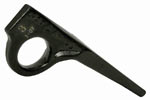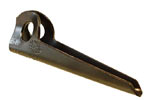Pitons (or pegs as they are often known in Britain) are, since the advent of modern wires, nuts and camming devices, seldom used in the UK for summer rock-climbing any more. However they are an important tool in winter and alpine climbing where narrow cracks may be choked with ice and other protection hard to find. They are also used in big wall aid climbing.
Pitons are either Chrome-Molybdenum Hard Steel (made for repeated use) or Mild Steel that deforms to the rock (made for permanent placements). All the pegs we sell are Hard Steel except where clearly indicated otherwise.
Pegs: the four major types |
| Knifeblades |
 |
Thin blade pegs for fine cracks (1 - 3mm) and are the most useful and lightest to carry.
|
| Kingpins |
 |
Also known as Lost Arrows. Fat blades made for wider cracks (4 - 7mm). They are rather heavy.
|
| Leepers |
 |
Designed and made by American climber Ed Leeper. The term has become generic. They are like channels but with a double U shape, making them suitable for crack sizes in between Kingpins and Channels ( 8 - 15mm). They no longer seem to be in production.
|
| Channels |
 |
Also known as Angles. U or V-shaped pitons made from formed steel sheet for wide cracks (15mm - 25mm).
|
Knowing what pitons (and indeed what gear in general) to carry for winter climbing is something that comes with experience. The requirements vary from area to area as well. For instance in the Cairngorms, cams may be found more useful than pegs, whereas on Ben Nevis it is well worth carrying a selection of pitons. The trick is to get the right balance between weight and safety.
Here is a typical Ben Nevis selection: Knifeblade Long x 1, Knifeblade Medium x 1, Channel Medium x 1, Kingpin x 1 (this last item is quite heavy and many would not carry one but they are useful in iced up cracks that are slightly wider than blade size). Additional pegs that might be considered are a larger Channel, and a Leeper (if you can find one).